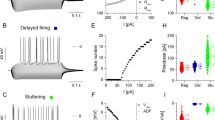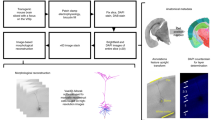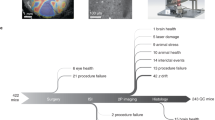Abstract
Characterizing the functional phenotypes of neurons is essential for understanding how genotypes can be related to the neural basis of behaviour. Traditional classifications of neurons by single features (such as morphology or firing behaviour) are increasingly inadequate for reflecting functional phenotypes, as they do not integrate functions across different neuronal types. Here, we describe a set of rules for identifying and predicting functional phenotypes that combine morphology, intrinsic ion channel species and their distributions in dendrites, and functional properties. This more comprehensive neuronal classification should be an improvement on traditional classifications for relating genotype to functional phenotype.
This is a preview of subscription content, access via your institution
Access options
Subscribe to this journal
Receive 12 print issues and online access
$189.00 per year
only $15.75 per issue
Buy this article
- Purchase on Springer Link
- Instant access to full article PDF
Prices may be subject to local taxes which are calculated during checkout






Similar content being viewed by others
References
Llinas, R. R. The intrinsic electrophysiological properties of mammalian neurons: insights into central nervous system function. Science 242, 1654–1664 (1988).
Migliore, M. & Shepherd, G. M. Emerging rules for the distributions of active dendritic conductances. Nature Rev. Neurosci. 3, 362–370 (2002).
Toledo-Rodriguez, M. et al. Correlation maps allow neuronal electrical properties to be predicted from single-cell gene expression profiles in rat neocortex. Cereb. Cortex 14, 1310–1327 (2004).
Frick, A., Magee, J., Koester, H. J., Migliore, M. & Johnston, D. Normalization of Ca2+ signals by small oblique dendrites of CA1 pyramidal neurons. J. Neurosci. 23, 3243–3250 (2003).
Stuart, G. & Hausser, M. Initiation and spread of sodium action potentials in cerebellar Purkinje cells. Neuron 13, 703–712 (1994).
Williams, S. R. & Stuart, G. J. Action potential backpropagation and somato-dendritic distribution of ion channels in thalamocortical neurons. J. Neurosci. 20, 1307–1317 (2000).
Trimmer, J. S. & Rhodes, K. J. Localization of voltage-gated ion channels in mammalian brain. Annu. Rev. Physiol. 66, 477–519 (2004).
Larkum, M. E., Zhu, J. J. & Sakmann, B. A new cellular mechanism for coupling inputs arriving at different cortical layers. Nature 398, 338–341 (1999).
Womack, M. D. & Khodakhah, K. Dendritic control of spontaneous bursting in cerebellar Purkinje cells. J. Neurosci. 24, 3511–3521 (2004).
Magee, J. C. Dendritic hyperpolarization-activated currents modify the integrative properties of hippocampal CA1 pyramidal neurons. J. Neurosci. 18, 7613–7624 (1998).
Waters, J., Schaefer, A. & Sakmann, B. Backpropagating action potentials in neurones: measurement, mechanisms and potential functions. Prog. Biophys. Mol. Biol. 87, 145–170 (2005).
Hoffman, D. A., Magee, J. C., Colbert, C. M. & Johnston, D. K+ channel regulation of signal propagation in dendrites of hippocampal pyramidal neurons. Nature 387, 869–875 (1997).
Stuart, G. J. & Sakmann, B. Active propagation of somatic action potentials into neocortical pyramidal cell dendrites. Nature 367, 69–72 (1994).
Williams, S. R. & Stuart, G. J. Site independence of EPSP time course is mediated by dendritic Ih in neocortical pyramidal neurons. J. Neurophysiol. 83, 3177–3182 (2000).
Berger, T., Larkum, M. E. & Luscher, H. R. High Ih channel density in the distal apical dendrite of layer V pyramidal cells increases bidirectional attenuation of EPSPs. J. Neurophysiol. 85, 855–868 (2001).
Lorincz, A., Notomi, T., Tamas, G., Shigemoto, R. & Nusser, Z. Polarized and compartment-dependent distribution of HCN1 in pyramidal cell dendrites. Nature Neurosci. 5, 1185–1193 (2002).
Hausser, M., Stuart, G., Racca, C. & Sakmann, B. Axonal initiation and active dendritic propagation of action potentials in substantia nigra neurons. Neuron 15, 637–647 (1995).
D'Antuono, M., Biagini, G., Tancredi, V. & Avoli, M. Electrophysiology of regular firing cells in the rat perirhinal cortex. Hippocampus 11, 662–672 (2001).
Van der Linden, S. & Lopes da Silva, F. H. Comparison of the electrophysiology and morphology of layers III and II neurons of the rat medial entorhinal cortex in vitro. Eur. J. Neurosci. 10, 1479–1489 (1998).
Buckmaster, P. S., Alonso, A., Canfield, D. R. & Amaral, D. G. Dendritic morphology, local circuitry, and intrinsic electrophysiology of principal neurons in the entorhinal cortex of macaque monkeys. J. Comp. Neurol. 470, 317–329 (2004).
Protopapas, A. D. & Bower, J. M. Physiological characterization of layer III non-pyramidal neurons in piriform (olfactory) cortex of rat. Brain Res. 865, 1–11 (2000).
Cooper, A. J. & Stanford, I. M. Electrophysiological and morphological characteristics of three subtypes of rat globus pallidus neurone in vitro. J. Physiol. (Lond.) 527, 291–304 (2000).
Kaiser, K. M., Zilberter, Y. & Sakmann, B. Back-propagating action potentials mediate calcium signalling in dendrites of bitufted interneurons in layer 2/3 of rat somatosensory cortex. J. Physiol. (Lond.) 535, 17–31 (2001).
Lien, C. C., Martina, M., Schultz, J. H., Ehmke, H. & Jonas, P. Gating, modulation and subunit composition of voltage-gated K+ channels in dendritic inhibitory interneurones of rat hippocampus. J. Physiol. (Lond.) 538, 405–419 (2002).
Bennett, B. D., Callaway, J. C. & Wilson, C. J. Intrinsic membrane properties underlying spontaneous tonic firing in neostriatal cholinergic interneurons. J. Neurosci. 20, 8493–8503 (2000).
Koizumi, A., Jakobs, T. C. & Masland, R. H. Inward rectifying currents stabilize the membrane potential in dendrites of mouse amacrine cells: patch-clamp recordings and single-cell RT-PCR. Mol. Vis. 10, 328–340 (2004).
Bischofberger, J. & Jonas, P. Action potential propagation into the presynaptic dendrites of rat mitral cells. J. Physiol. (Lond.) 504, 359–365 (1997).
Holderith, N. B., Shigemoto, R. & Nusser, Z. Cell type-dependent expression of HCN1 in the main olfactory bulb. Eur. J. Neurosci. 18, 344–354 (2003).
Waters, J., Larkum, M., Sakmann, B. & Helmchen, F. Supralinear Ca2+ influx into dendritic tufts of layer 2/3 neocortical pyramidal neurons in vitro and in vivo. J. Neurosci. 23, 8558–8567 (2003).
Maravall, M., Stern, E. A. & Svoboda, K. Development of intrinsic properties and excitability of layer 2/3 pyramidal neurons during a critical period for sensory maps in rat barrel cortex, J. Neurophysiol. 92, 144–156 (2004).
Faber, E. S., Callister, R. J. & Sah, P. Morphological and electrophysiological properties of principal neurons in the rat lateral amygdala in vitro. J. Neurophysiol. 85, 714–723 (2001).
Migliore, M., Hoffman, D., Magee, J. C. & Johnston, D. Role of an A-type K+ conductance in the back-propagation of action potentials in the dendrites of hippocampal neurons. J. Comput. Neurosci. 7, 5–15 (1999).
Margrie, T. W., Sakmann, B. & Urban, N. N. Action potential propagation in mitral cell lateral dendrites is decremental and controls recurrent and lateral inhibition in the mammalian olfactory bulb. Proc. Natl Acad. Sci. USA 98, 319–324 (2001).
Stewart, A. E. & Foehring, R. C. Effects of spike parameters and neuromodulators on action potential waveform-induced calcium entry into pyramidal neurons. J. Neurophysiol. 85, 1412–1423 (2001).
Magee, J. C. & Johnston, D. A synaptically controlled, associative signal for Hebbian plasticity in hippocampal neurons. Science 275, 209–213 (1997).
Martina, M., Yao, G. L. & Bean, B. P. Properties and functional role of voltage-dependent potassium channels in dendrites of rat cerebellar Purkinje neurons. J. Neurosci. 23, 5698–5707 (2003).
Velte, T. J. & Masland, R. H. Action potentials in the dendrites of retinal ganglion cells. J. Neurophysiol. 81, 1412–1417 (1999).
Buzsaki, G., Penttonen, M., Nadasdy, Z. & Bragin, A. Pattern and inhibition-dependent invasion of pyramidal cell dendrites by fast spikes in the hippocampus in vivo. Proc. Natl Acad. Sci. USA 93, 9921–9925 (1996).
Toris, C. B., Eiesland, J. L. & Miller, R. F. Morphology of ganglion cells in the neotenous tiger salamander retina. J. Comp. Neurol. 352, 535–559 (1995).
Pinato, G. & Midtgaard, J. Dendritic sodium spikelets and low-threshold calcium spikes in turtle olfactory bulb granule cells. J. Neurophysiol. 93, 1285–1294 (2005).
Song, D., Xie, X., Wang, Z. & Berger, T. W. Differential effect of TEA on long-term synaptic modification in hippocampal CA1 and dentate gyrus in vitro. Neurobiol. Learn. Mem. 76, 375–387 (2001).
Song, D., Wang, Z. & Berger, T. W. Contribution of T-type VDCC to TEA-induced long-term synaptic modification in hippocampal CA1 and dentate gyrus. Hippocampus 12, 689–697 (2002).
Williams, S. R., Christensen, S. R., Stuart, G. J. & Hausser, M. Membrane potential bistability is controlled by the hyperpolarization-activated current IH in rat cerebellar Purkinje neurons in vitro. J. Physiol. (Lond.) 539, 469–483 (2002).
Magee, J. C. Dendritic Ih normalizes temporal summation in hippocampal CA1 neurons. Nature Neurosci. 2, 508–514 (1999).
Migliore, M. On the integration of subthreshold inputs from perforant path and Schaffer collaterals in hippocampal CA1 pyramidal neurons. J. Comput. Neurosci. 14, 185–192 (2003).
Henderson, D. & Miller, R. F. Evidence for low-voltage-activated (LVA) calcium currents in the dendrites of tiger salamander retinal ganglion cells. Vis. Neurosci. 20, 141–152 (2003).
Lee, S. C., Hayashida, Y. & Ishida, A. T. Availability of low-threshold Ca2+ current in retinal ganglion cells. J. Neurophysiol. 90, 3888–3901 (2003).
Isope, P. & Murphy, T. H. Low threshold calcium currents in rat cerebellar Purkinje cell dendritic spines are mediated by T-type calcium channels. J. Physiol. (Lond.) 562, 257–269 (2005).
Usowicz, M. M., Sugimori, M., Cherksey, B. & Llinas, R. P-type calcium channels in the somata and dendrites of adult cerebellar Purkinje cells. Neuron 9, 1185–1199 (1992).
McQuiston, A. R. & Katz, L. C. Electrophysiology of interneurons in the glomerular layer of the rat olfactory bulb. J. Neurophysiol. 86, 1899–1907 (2001).
Schoppa, N. E. & Westbrook, G. L. Regulation of synaptic timing in the olfactory bulb by an A-type potassium current. Nature Neurosci. 2, 1106–1113 (1999).
Egger, V., Svoboda, K. & Mainen, Z. F. Mechanisms of lateral inhibition in the olfactory bulb: efficiency and modulation of spike-evoked calcium influx into granule cells. J. Neurosci. 23, 7551–7558 (2003).
Fisher, R. E., Gray, R. & Johnston, D. Properties and distribution of single voltage-gated calcium channels in adult hippocampal neurons. J. Neurophysiol. 64, 91–104 (1990).
Buckmaster, P. S. & Amaral, D. G. Intracellular recording and labeling of mossy cells and proximal CA3 pyramidal cells in macaque monkeys. J. Comp. Neurol. 430, 264–281 (2001).
Vasilyev, D. V. & Barish, M. E. Postnatal development of the hyperpolarization-activated excitatory current Ih in mouse hippocampal pyramidal neurons. J. Neurosci. 22, 8992–9004 (2002).
Golgi, C. Sulla Fina Anatomia Degli Organi Centrali del Sistema Nervoso (Hoepli, Milano, 1886)
Ramón y Cajal, S. Histologie du Système Nerveaux de l'Homme et des Vertebres Vol. II (Maloine, Paris, 1911).
Ramon-Moliner, E. in The Structure and Function of Nervous Tissue (ed. Bourne, G. H.) 205–267 (Academic, New York, 1968).
Kandel, E. R., Schwartz, J. H. & Jessell, T. M. Principles of Neural Science (McGraw-Hill, USA, 2000).
Shepherd, G. M. in The Synaptic Organization of the Brain (ed. Shepherd, G. M) 1–38 (Oxford Univ. Press, New York, 2004).
Douglas, R., Markram, H. & Martin, K. in The Synaptic Organization of the Brain (ed. Shepherd, G. M.) 499–558 (Oxford Univ. Press, New York, 2004).
Rall, W., Shepherd, G. M., Reese, T. S. & Brightman, M. W. Dendrodendritic synaptic pathway for inhibition in the olfactory bulb. Exp. Neurol. 14, 44–56 (1966).
Seamans, J. K. & Yang, C. R. The principal features and mechanisms of dopamine modulation in the prefrontal cortex. Prog. Neurobiol. 74, 1–58 (2004). Erratum: Prog. Neurobiol. 74, 321 (2004).
Trudeau, L. E. Glutamate co-transmission as an emerging concept in monoamine neuron function. J. Psychiatry Neurosci. 29, 296–310 (2004).
Cherubini, E., Gaiarsa, J. L. & Ben-Ari, Y. GABA: an excitatory transmitter in early postnatal life. Trends Neurosci. 14, 515–519 (1991).
Fuxe, K. & Hillarp, N. A. Uptake of L-DOPA and noradrenaline by central catecholamine neurons. Life Sci. 74, 1403–1406 (1964).
Williams, S. R., Toth, T. I., Turner, J. P., Hughes, S. W. & Crunelli, V. The 'window' component of the low threshold Ca2+ current produces input signal amplification and bistability in cat and rat thalamocortical neurones. J. Physiol. (Lond.) 505, 689–705 (1997).
Glanzer, J. G. & Eberwine, J. H. Mechanisms of translational control in dendrites. Neurobiol. Aging 24, 1105–1111 (2003).
Treloar, H. B., Uboha, U., Jeromin, A. & Greer, C. A. Expression of the neuronal calcium sensor protein NCS-1 in the developing mouse olfactory pathway. J. Comp. Neurol. 482, 201–216 (2005).
Stuart, G. & Spruston, N. Determinants of voltage attenuation in neocortical pyramidal neuron dendrites. J. Neurosci. 18, 3501–3510 (1998).
Spruston, N. & Johnston, D. Perforated patch-clamp analysis of the passive membrane properties of three classes of hippocampal neurons. J. Neurophysiol. 67, 508–529 (1992).
Williams, S. R. & Stuart, G. J. Mechanisms and consequences of action potential burst firing in rat neocortical pyramidal neurons. J. Physiol. (Lond.) 521, 467–482 (1999).
Morin, F., Beaulieu, C. & Lacaille, J. C. Membrane properties and synaptic currents evoked in CA1 interneuron subtypes in rat hippocampal slices. J. Neurophysiol. 76, 1–16 (1996).
Bennett, B. D. & Wilson, C. J. Spontaneous activity of neostriatal cholinergic interneurons in vitro. J. Neurosci. 19, 5586–5596 (1999).
Manis, P. B. Membrane properties and discharge characteristics of guinea pig dorsal cochlear nucleus neurons studied in vitro. J. Neurosci. 10, 2338–2351 (1990).
Chen, W. R. & Shepherd, G. M. Membrane and synaptic properties of mitral cells in slices of rat olfactory bulb. Brain Res. 745, 189–196 (1997).
Mason, A. & Larkman, A. Correlations between morphology and electrophysiology of pyramidal neurons in slices of rat visual cortex. II. Electrophysiology. J. Neurosci. 10, 1415–1428 (1990).
Kroner, S., Gottmann, K., Hatt, H. & Gunturkun, O. Electrophysiological and morphological properties of cell types in the chick neostriatum caudolaterale. Neuroscience 110, 459–473 (2002).
Hughes, S. W., Cope, D. W. & Crunelli, V. Dynamic clamp study of Ih modulation of burst firing and δ oscillations in thalamocortical neurons in vitro. Neuroscience 87, 541–550 (1998).
Swensen, A. M. & Bean, B. P. Ionic mechanisms of burst firing in dissociated Purkinje neurons. J. Neurosci. 23, 9650–9663 (2003).
Chang, W., Strahlendorf, J. C. & Strahlendorf, H. K. Ionic contributions to the oscillatory firing activity of rat Purkinje cells in vitro. Brain Res. 614, 335–341 (1993).
Sheasby, B. W. & Fohlmeister, J. F. Impulse encoding across the dendritic morphologies of retinal ganglion cells. J. Neurophysiol. 81, 1685–1698 (1999).
Tabata, T. & Ishida, A. T. Transient and sustained depolarization of retinal ganglion cells by Ih. J. Neurophysiol. 75, 1932–1943 (1996).
Molitor, S. C. & Manis, P. B. Dendritic Ca2+ transients evoked by action potentials in rat dorsal cochlear nucleus pyramidal and cartwheel neurons. J. Neurophysiol. 89, 2225–2237 (2003).
Manis, P. B., Spirou, G. A., Wright, D. D., Paydar, S. & Ryugo, D. K. Physiology and morphology of complex spiking neurons in the guinea pig dorsal cochlear nucleus. J. Comp. Neurol. 348, 261–276 (1994).
D'Angelo, E. et al. Theta-frequency bursting and resonance in cerebellar granule cells: experimental evidence and modeling of a slow K+-dependent mechanism. J. Neurosci. 21, 759–770 (2001).
St. John, J. L., Rosene, D. L. & Luebke, J. I. Morphology and electrophysiology of dentate granule cells in the rhesus monkey: comparison with the rat. J. Comp. Neurol. 387, 136–147 (1997).
Acknowledgements
We are grateful for support from the National Institutes of Health, the Human Brain Project (funded by the National Institute of Deafness and Other Communication Disorders, the National Institute of Mental Health, the National Institute of Neurological Disorders and Stroke, and the National Institute on Aging) and the Office of Naval Research (Multi-university Research Initiative). We thank W. Chen, T. Morse, D. Willhite and M. Hines for valuable discussions.
Author information
Authors and Affiliations
Corresponding author
Ethics declarations
Competing interests
The authors declare no competing financial interests.
Related links
Rights and permissions
About this article
Cite this article
Migliore, M., Shepherd, G. An integrated approach to classifying neuronal phenotypes. Nat Rev Neurosci 6, 810–818 (2005). https://doi.org/10.1038/nrn1769
Issue Date:
DOI: https://doi.org/10.1038/nrn1769
This article is cited by
-
Laminar compartmentalization of attention modulation in area V4 aligns with the demands of visual processing hierarchy in the cortex
Scientific Reports (2023)
-
Degeneracy in the emergence of spike-triggered average of hippocampal pyramidal neurons
Scientific Reports (2020)
-
Quantitative firing pattern phenotyping of hippocampal neuron types
Scientific Reports (2019)
-
Development of lentiviral vectors for efficient glutamatergic-selective gene expression in cultured hippocampal neurons
Scientific Reports (2018)
-
Single-cell analysis of diversity in human stem cell-derived neurons
Cell and Tissue Research (2018)



